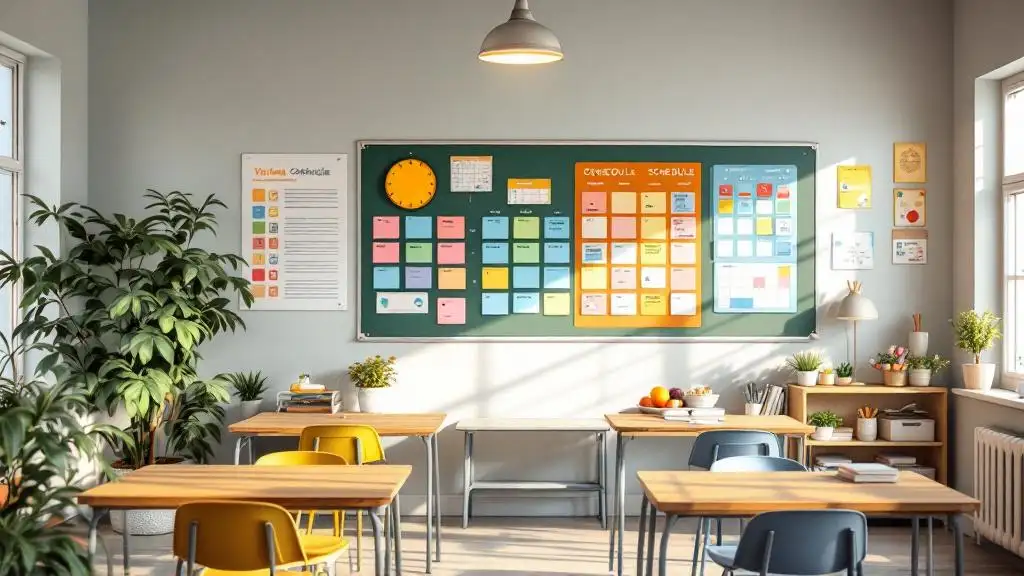Introduction to Visual Schedules and Their Impact
Visual schedules are vital tools in supporting children with autism by providing clear, structured cues that facilitate understanding, reduce anxiety, and promote independence. These tools serve as visual roadmaps, helping children comprehend routines, transition smoothly between activities, and feel more secure in their daily environments. By exploring various form factors and implementation strategies, caregivers and educators can harness the power of visual schedules to foster positive behavioral outcomes and enhance communication.
Understanding What Visual Schedules Are and Their Supporting Role
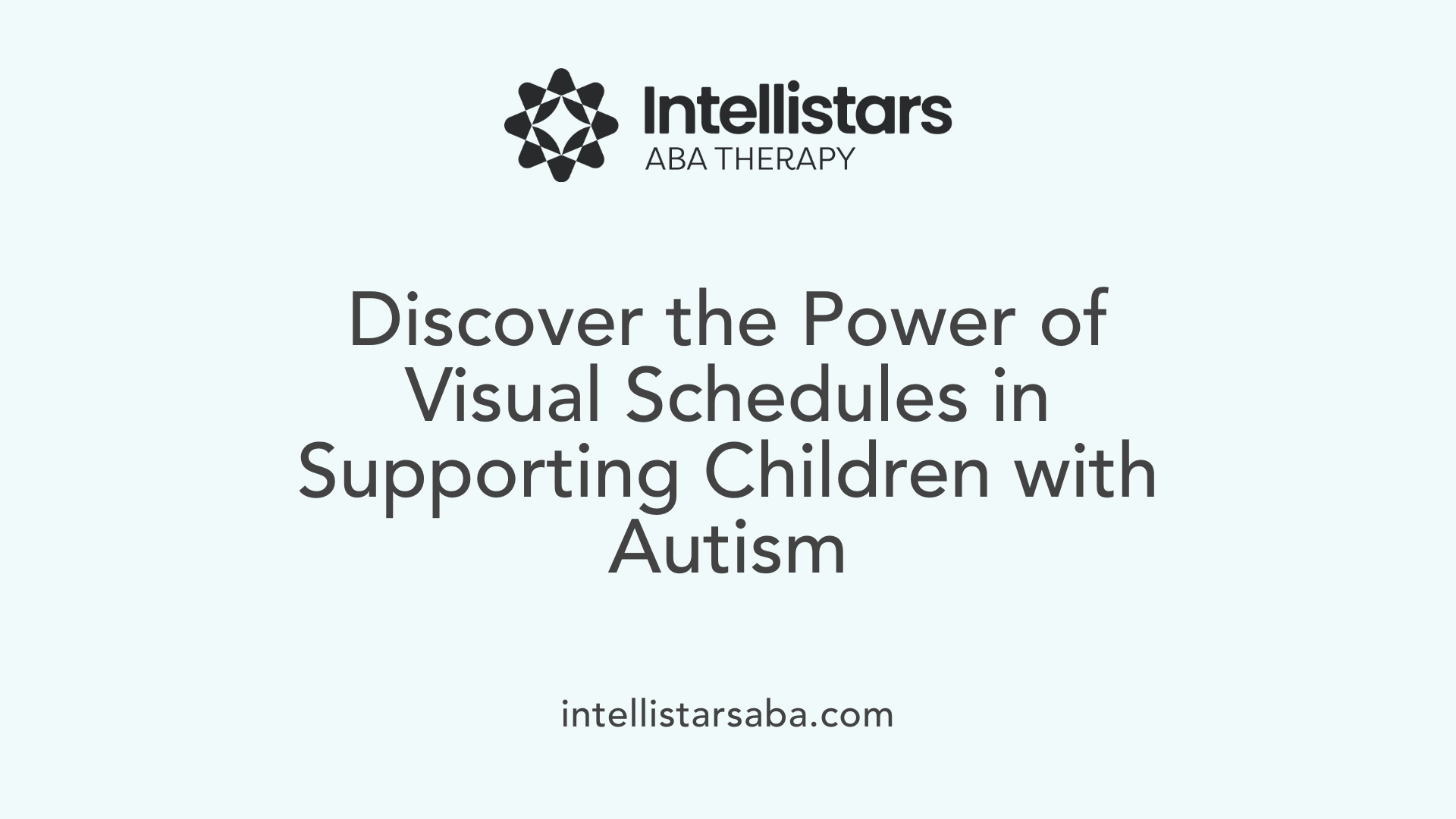
What are visual schedules and how do they support children with autism?
Visual schedules are personalized tools that use visuals such as pictures, icons, or words to show a sequence of activities or routines a child is expected to follow. These visual representations act as a clear guide, helping children understand what activities are upcoming or what steps they need to complete.
They serve as a 'roadmap' by providing predictable structure in daily routines, which is especially beneficial for children with autism. This predictability helps reduce feelings of uncertainty and anxiety that often occur during transitions or new activities.
Visual schedules can be created using various formats—ranging from picture-based charts, written lists, digital displays, or a combination of these. They can be tailored to suit individual needs, visual preferences, and developmental levels.
In practical use, these schedules support children in managing transitions between tasks smoothly. For example, a child might see a series of pictures representing morning routines like brushing teeth, getting dressed, and breakfast, enabling them to anticipate and prepare for each step.
Beyond promoting independence, visual schedules enhance communication by providing visual cues that support understanding, especially for children with limited verbal skills. They help children grasp instructions and concepts more easily, making daily activities less overwhelming.
Research indicates that visual schedules are highly effective, improving focus, reducing problem behaviors, and fostering self-regulation. They are versatile tools adaptable for home, school, and community settings, and can be simple or detailed depending on the child's needs.
Overall, visual schedules are a valuable resource that helps children with autism navigate their routines with confidence, calmness, and greater independence.
The Multiple Benefits of Visual Schedules for Children with Autism
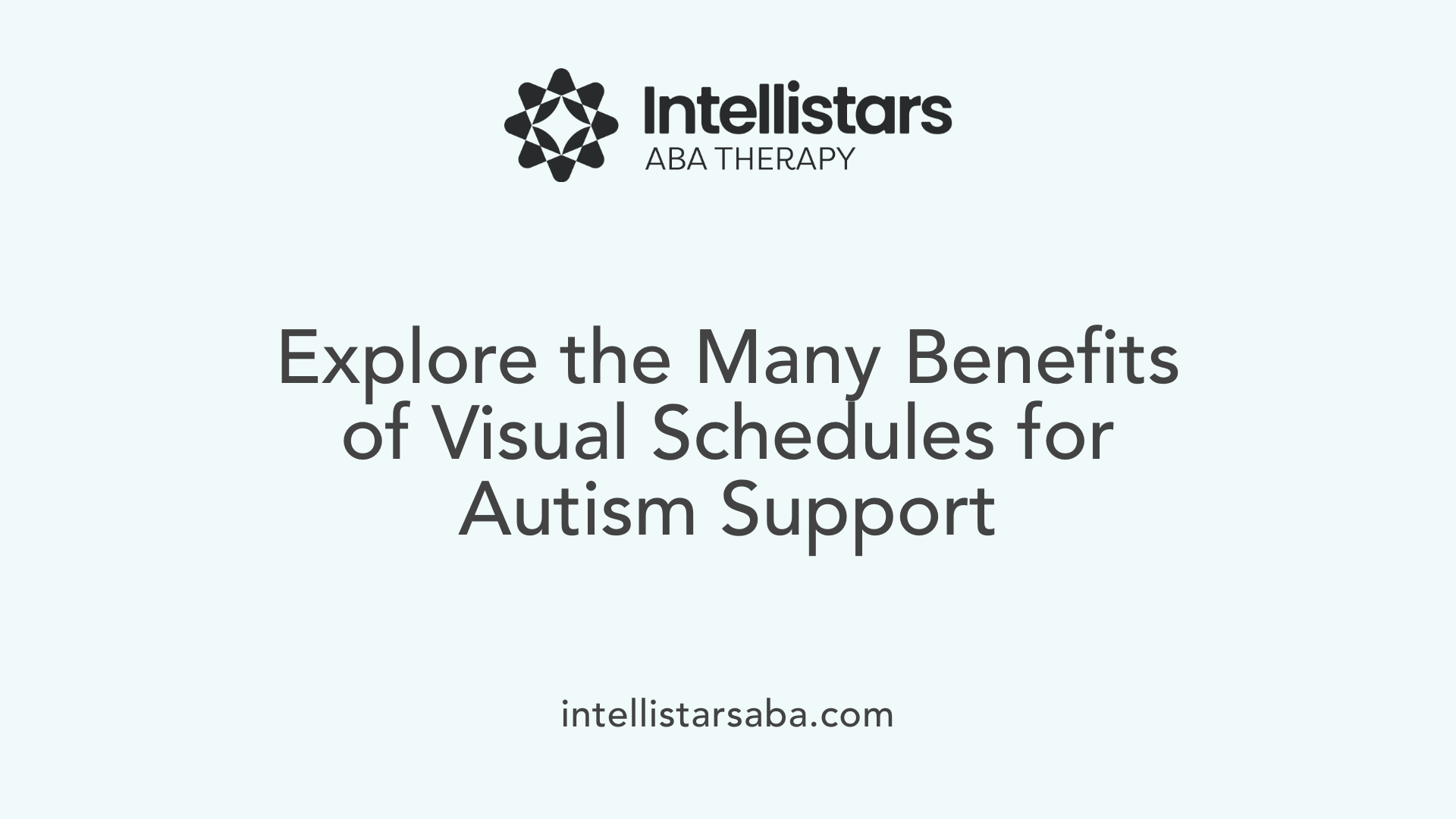
Promoting predictability and reducing anxiety
Visual schedules are invaluable tools for children with autism because they bring predictability to daily routines. By providing a clear sequence of activities through pictures, icons, or words, these schedules help children know what to expect next. This anticipation reduces feelings of uncertainty and helps lessen anxiety, especially during transitions or unfamiliar situations.
Encouraging independence and self-management
One of the main advantages of visual schedules is their role in fostering independence. When children are able to follow a visual plan, they can complete tasks and transition between activities with less adult prompting. This promotes self-management skills as children learn to navigate their daily routines, increasing confidence and autonomy.
Supporting understanding and communication
Visual schedules significantly support comprehension and communication, particularly for children with language delays or difficulty expressing themselves verbally. The visual representations make abstract concepts more concrete, aiding understanding. They also serve as visual prompts that can help children learn new words and develop language skills.
Enhancing attention and focus
Using visual schedules helps children concentrate on upcoming activities, reducing distractions and increasing engagement. The structured format directs their attention and helps them stay focused on the task at hand, which can improve overall learning and behavior.
Facilitating smooth transitions
Transitions between activities often cause stress for children with autism. Visual schedules act as visual cues that signal changes, helping children prepare mentally and emotionally. This smoother transition reduces resistance and behavioral challenges often associated with routine changes.
Building confidence and reducing problem behaviors
When children understand their routines through visual supports, they tend to feel more secure and in control. This boost in confidence can decrease problem behaviors related to frustration, anxiety, or resistance to changes. Visual schedules create a sense of structure that encourages positive behavior and independence.
| Benefit | Description | Suitable For |
|---|---|---|
| Predictability | Clarifies routines, reduces anxiety | Children with autism, anxiety issues |
| Independence | Fosters self-management | Children learning daily routines |
| Communication | Illustrates steps, aids language | Language delays, autism |
| Attention | Improves focus on activities | All children |
| Transitions | Signals upcoming changes | Children sensitive to routine shifts |
| Confidence | Builds self-esteem, reduces behavior issues | Children with behavior challenges |
Research supports that visual supports leverage children’s strengths in visuospatial skills and attention, making them especially effective. Tailoring schedules to individual needs ensures maximum benefit in various environments such as home, school, or community settings.
Steps to Effectively Create and Implement Visual Schedules

Assessing the child's needs and routines
The first step in creating a successful visual schedule is to understand the child's unique needs, routines, and abilities. This involves identifying which activities the child finds challenging, stressful, or confusing. For example, children with autism may have difficulty transitioning between tasks or understanding what comes next. By observing their daily activities, caregivers can determine which routines to include in the schedule and how detailed it should be.
Choosing visual formats (pictures, icons, words)
Selecting the appropriate visual representation is crucial. Depending on the child's age, language skills, and preferences, visuals can include photographs, drawings, icons, or simple written words. For children with limited language skills, pictures or objects might be more effective, while older or more verbal children may benefit from written labels. The visuals should be clear, consistent, and meaningful to the child.
Gathering and organizing visuals
Caregivers need to gather visuals relevant to the child's routines. This might involve taking photographs of activities, printing icons from online resources, or creating drawings. It’s also helpful to organize these visuals in logical order, either as individual cards or on a board. Grouping related activities together can make the schedule easier to understand and follow.
Introducing the schedule positively
Introducing the visual schedule should be a positive experience. Caregivers can explain the purpose of the schedule, emphasizing that it will help the child understand what to expect and make transitions easier. Demonstrating how to use it through modeling and providing praise during initial sessions helps foster motivation and reduces any potential anxiety.
Placing the schedule accessibly
The visual schedule should be placed in a location that is easily accessible to the child, such as at their eye level or in their personal space. Portable options like laminated cards or a picture book allow for flexibility and use in various settings, including at home, school, or community areas.
Teaching the child how to use it
Children should be explicitly taught how to use their visual schedule. This involves guiding them through the process of looking at the visuals, understanding what each one means, and completing the corresponding activities. Using prompts initially and gradually fading assistance encourages independence. Reinforcing the use of visual cues helps the child learn self-management skills.
Regular review and adjustments
A visual schedule isn’t static; it should evolve based on the child's progress and changing routines. Regularly reviewing the schedule and making adjustments ensures it remains relevant and effective. If the child completes activities quickly, additional tasks can be added. For more challenging routines, simplifying or breaking down activities can help.
Reinforcing independence and success
Celebrating the child's successes in following the schedule boosts confidence and motivation. Encouragement, rewards, and positive feedback foster independence and help transfer the skills to other environments. As children become more comfortable using their schedules, they can take more responsibility for managing their routines, reducing reliance on prompts and increasing self-regulation.
Best Practices for Using Visual Schedules
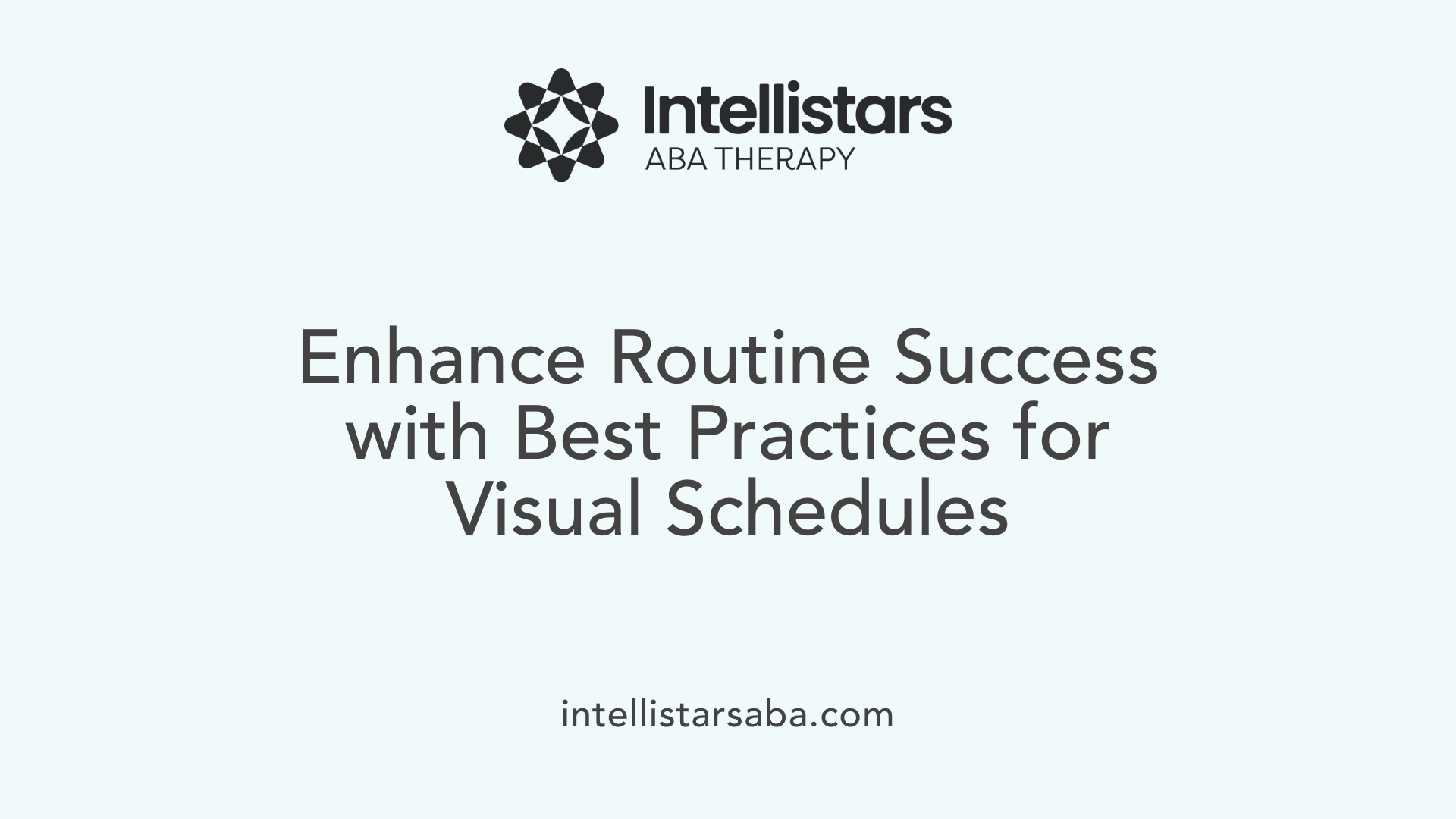 When implementing visual schedules for children with autism, it is crucial to follow some best practices to maximize their effectiveness. First, customization is essential. The visuals used should align with the child's interests, preferences, and developmental needs. Whether using photographs, icons, or written words, the schedule should be tailored to suit each child's comprehension level and sensory sensitivities.
When implementing visual schedules for children with autism, it is crucial to follow some best practices to maximize their effectiveness. First, customization is essential. The visuals used should align with the child's interests, preferences, and developmental needs. Whether using photographs, icons, or written words, the schedule should be tailored to suit each child's comprehension level and sensory sensitivities.
Maintaining simplicity and consistency in the schedule helps children understand what to expect. A clear, predictable routine reduces anxiety and encourages independent use. It’s useful to keep the sequence gradual and avoid overwhelming with too many steps at once.
Explicit teaching plays a vital role. Adults should clearly explain how to use the schedule, demonstrating the process and encouraging the child to participate. Modeling behavior helps children learn how to interact with visuals effectively.
Positive reinforcement encourages continued engagement. Praising the child for using the schedule correctly, or offering small rewards, can motivate them to follow routines more consistently.
Gradually fading prompts is another useful strategy. Start with a lot of guidance and assistance, then slowly reduce help, fostering greater independence. When children begin to use the schedule independently, they gain confidence and self-regulation skills.
Supporting skill development can be achieved by allowing children to manipulate the visuals. Moving pictures, crossing out completed tasks, or marking items off teaches planning and organization skills.
Flexibility is important. Each child is unique; therefore, schedules should accommodate individual differences, including the need to adjust for mood, attention span, or unexpected changes. This adaptability ensures that visual supports remain relevant and effective over time.
In summary, best practices include customizing visuals to the child's interests, keeping routines predictable, teaching explicitly, reinforcing positive behavior, gradually reducing prompts, supporting their ability to manipulate visuals, and maintaining flexibility to meet individual needs. These strategies promote independence, reduce anxiety, and support skill mastery through consistent, tailored use of visual schedules.
Effective Techniques for Utilizing Visual Schedules
What techniques can be used to effectively utilize visual schedules for children with autism?
Using visual schedules with children who have autism can significantly improve their understanding of routines and reduce anxiety. To make the most of these tools, several effective techniques should be employed.
Firstly, selecting clear and consistent visuals is essential. These visuals—whether photographs, icons, or objects—must be meaningful and easily recognizable to the child. Consistency in visuals helps avoid confusion and builds familiarity, which encourages independence.
The placement of the visual schedule also matters. It should be in a visible, accessible spot, such as at the child's eye level. This placement ensures the child can regularly check the schedule and anticipate upcoming activities. Regular review of the schedule reinforces understanding and helps prepare the child for transitions.
Involving the child in the process can boost motivation. By allowing them to choose or arrange visuals, children feel a sense of ownership and engagement with their routines. This involvement can be especially motivating and enhance compliance.
Explicit instruction and modeling are crucial. Caregivers and educators should teach children how to interpret and follow the visuals step-by-step. Starting with simple routines and gradually introducing more complex schedules helps build confidence and skill.
Reinforcement through praise or small rewards can encourage consistent use. When a child successfully follows the schedule, acknowledging their effort fosters positive behavior and reinforces learning.
Another important technique is systematically fading prompts. Initially, hand-over-hand guidance or additional cues can support the child, but these should be gradually reduced as the child gains confidence and independence.
Finally, ensuring cross-setting consistency helps the child transfer skills across home, school, and community settings. Using the same types of visuals and similar routines supports generalization and stability in their daily experiences.
By applying these strategies, caregivers and educators can optimize the positive impact of visual schedules, helping children with autism navigate their routines with greater ease and confidence.
Involving Family and Community in Visual Schedule Use
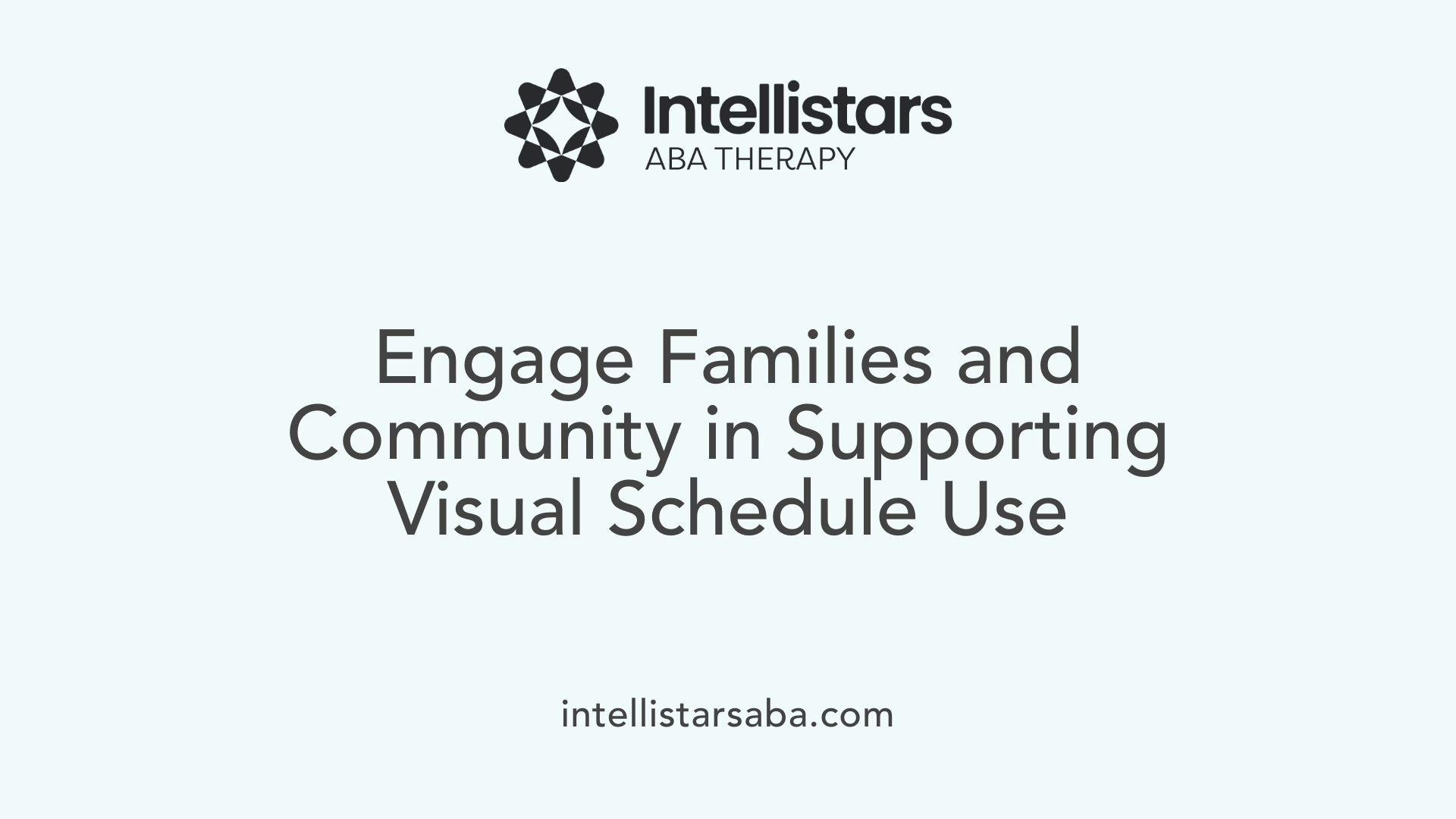
How can parents participate in creating visual schedules?
Parents play a crucial role in developing effective visual supports for their children. They can actively participate by understanding their child’s routines and specific needs. Gathering visuals such as photographs, pictures, or symbols that are meaningful to the child is essential. Parents can involve their children in selecting these visuals, making the schedule more personalized and engaging.
Creating a visual schedule together encourages children to understand and anticipate daily activities. Parents may organize the schedule in a way that reflects the child's routines, ensuring it is easy to follow. Using materials like printed images, drawings, or digital tools can help tailor the schedule to suit the child’s preferences and comprehension level.
Moreover, involving family in the creation process fosters consistency across different environments. Active participation helps reinforce the use of the schedule at home and beyond, supporting better understanding and cooperation. Parents should also practice guiding their children on how to use the schedule independently, gradually fading prompts as the child gains confidence.
In summary, parent involvement in crafting visual schedules not only empowers families but also enhances the child's learning and independence. Techniques can include selecting visuals, organizing the schedule, and consistently implementing it within daily routines.
Conclusion: Empowering Children with Autism through Visual Supports
Visual schedules are invaluable tools that help children with autism by providing structure, clarity, and predictability. They promote independence, reduce anxiety, and support better communication and transitions across settings. These benefits make daily routines smoother for both children and their caregivers.
Successfully implementing visual schedules involves understanding the child's individual needs, selecting appropriate visual representations, and gradually teaching the child how to use them independently. Continuous observation and adjustments ensure the schedules remain relevant and effective.
Caregivers and professionals play a crucial role in creating and maintaining these supports. Their involvement — from designing visuals to guiding children in use — fosters confidence and fosters skill development.
Embracing visual supports empowers children to navigate their routines confidently, leading to improved behavior and greater independence. Regular evaluation and adaptation of these tools ensure they continue to meet evolving needs, making them an essential part of supporting children with autism.
Final Thoughts: Building a Supportive Environment
Implementing visual schedules effectively can significantly improve the daily lives of children with autism by providing structure, predictability, and a sense of control. These tools help children understand routines, manage transitions, and develop independence, ultimately fostering a more calming and successful environment both at home and in educational settings. Caregivers, educators, and professionals are encouraged to tailor visual supports to each child's unique needs, consistently teach and reinforce their use, and involve family members in the process. When used thoughtfully and systematically, visual schedules become powerful allies in promoting positive behaviors, enhancing communication, and empowering children to thrive.
References
- A Practical Guide to Creating Visual Schedules
- Why & How to Use Visual Schedules
- Visual Schedules in the School Setting
- Visual schedules & supports: autism
- Visual Schedule Series: First-Then Schedules (Freebie!!)
- How to Make a Visual Schedule for an Autistic Child
- Visual Schedules: Tools to Support Young People with ...
- Visual Schedules | Nebraska Autism Spectrum Disorders ...
- A Practical Guide to Creating Visual Schedules
- Visual Schedules in the School Setting

